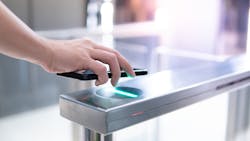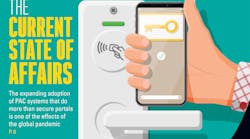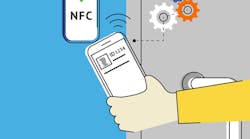This article originally appeared in Access Control Trends & Technology, an annual bonus publication to Security Business magazine and Security Technology Executive magazine.
A successful access control project requires a collaborative effort among end users, and experts and employing industry standards
The demand for contactless access control solutions is increasing. The challenge is to offer a seamless user experience without affecting the corporate security level. The ubiquitous smartphone brings immense potential for new access control uses and better integration in our daily lives. Always available virtual badges are easier to use, reduce loss and theft and speed up access processes. And worldwide standards are helping to make scalable mobile solutions a reality today.
Cyber and Physical Threats
The mobile workforce is here to stay. This year, Strategy Analytics predicts the global workforce will have 1.87 billion mobile employees, 42.5% of the total workforce. More mobility brings an increase in threats with the IT infrastructure of both large and small organizations often subject to attacks in both the physical and digital world. A nefarious person with physical access to the corporate server room or a workstation connected to the network may access critical IT systems with disastrous consequences. The complete infrastructure may be taken hostage or made inaccessible, which will impact all business processes and endanger the continuity of the organization. Ninety percent of companies believe their data is at risk.
The loss or theft of sensitive and confidential data may also have serious financial implications or result in damage to the company's reputation.
Securing the corporate IT infrastructure and systems should not only be about information security. The physical security of IT facilities and any physical access points to the network should be an integral part of security planning and policies.
Today, more than ever, security and access control systems need to be flawless and standardized.
Numerous organizations are still using outdated technology (125 kHz, MIFARE Classic, HID iCLASS). Yesterday's access control solutions lead to higher maintenance costs and difficulties finding replacements as standards are adopted. A bigger concern is the physical badges can be easily copied using equipment readily available online. These security flaws impact the integrity and security of data. Again, flawless security is critical to a healthy enterprise.
Access Control Management Instantly Simplified
The management of physical access cards can be a daily headache. Hand delivering access badges to users, the hassle and security risk of lost badges, and the timely revocation of access rights are just a few of the activities taking up a manager's time.
Instead of presenting a physical badge to the access control system, users can now present their mobile credentials to the reader. Just bring your phone and you will get access to buildings, rooms, sites, and other secured zones that you have been authorized to access. The reality is that 98% of employees consider access control to be obstructive at times. Considering that we pass through an average of 11 accesses per day, there are many opportunities to reduce friction between access control and employees.
Virtual badges greatly reduce the time required for access management and offer so many additional benefits. By transferring the access badge to a smartphone for visitors, subcontractors and employees, your organization will instantly simplify card management! The creation, distribution and revocation of virtual access badges can be executed immediately, at any time, at any location in the world. People can start using their badges right away. And when their access rights are no longer valid, revoking the badge is a piece of cake. Digital access cards are much more effective and flexible for both users and managers. New apps allow users to store multiple digital ID cards so they’re always accessible.
An important point to keep in mind: the cost of a virtual badge is two to five times less than that of a physical badge. A recent study demonstrates that over 50% of the operational costs of physical card management are related to printing, customization and distribution of the cards. With virtual badges, no more consumables, no more printing and personalization costs, no more recycling costs, and no more expenses related to loss or damage. Instead, your company will benefit from economies of scale and greater operational efficiency, in an "eco-friendly" fashion. The benefits of mobile are abundant and apparent to many. In fact, industry leaders estimate that 75% of business is already migrating to virtual credentials.
With Secure Mobile Solutions, Possibilities are Endless
Understandably, new technology adoption can bring fear of complicated organizational operations and more work for an already burdened IT department. While the need for a high-security system is obvious, the implementation may be overwhelming. The modularity of an access control system helps break down the barriers.
Why? A modular reader can be adapted to meet future needs: the system can evolve toward the use of QR-codes to facilitate visitor access, use of a smartphone as an access key, or add an additional layer of security by integrating smartphone biometrics. And with mobile comes many possibilities for value-add solutions like combining identity management and access to printing solutions, leisure and event subscription solutions, etc. The smartphone can bring new possibilities for mobility.
Vehicle identification is another perfect example of a seamless process that expedites security and operations. A smartphone can automatically identify the vehicle and/or its driver, allowing vehicle access control to be as seamless and instinctive as the high-security identification of individuals. With the smartphone, access can be controlled in real time, ensuring that the vehicle can enter the parking lot and that the driver is fully authorized to do so.
But this need for intuitiveness must not be at the expense of security. It is crucial to guarantee the protection and confidentiality of data.
Standards Help Mobile Access Control
With mobile devices – both iOS and Android – being used in high-security buildings, car parks and more, technology standards are crucial to ensure that security is never compromised.
Standards allow interoperability and they support the fight against “technological obscurantism”. Industry standards are absolute necessities today to help clients compose their best-of-breed security solutions. Security departments are becoming aware of the importance of choosing trusted technologies that guarantee certified and interoperable security. System integrators and solutions providers encourage their user partners to select the access control, security management solution or any other security-related system that best matches their requirements. Faced with the growing threats of physical and cyber-attacks, it’s important to provide flawless security, based on OSDP and SSCP protocols.
Indeed, the Security Industry Association (SIA) Open Supervised Device Protocol (OSDP™) standard for access control security has been key to providing a first level of uniform security worldwide. Industry leaders have worked with the International Electrotechnical Commission (IEC) to create these stringent global standards.
Definitely secured by design, the communication protocol SSCP guarantees the protection and confidentiality of data and that customers are in full control of their application and their security keys.
Teamwork Needed for Successful Mobile Access Control
A successful access control project is based on real collaboration between end users, and experts and the employment of industry standards. It must match your company's needs and requirements from development to implementation.
How can this be achieved? It starts with a complete and thorough analysis of the access points, the technologies in use, the required security levels and the practical use cases. Only after the needs are clearly defined and a roadmap is created should the project begin. Then your organization can move toward a high-security access control system that will successfully mitigate security risks while improving adoption, ease of use and overall operational efficiency.








